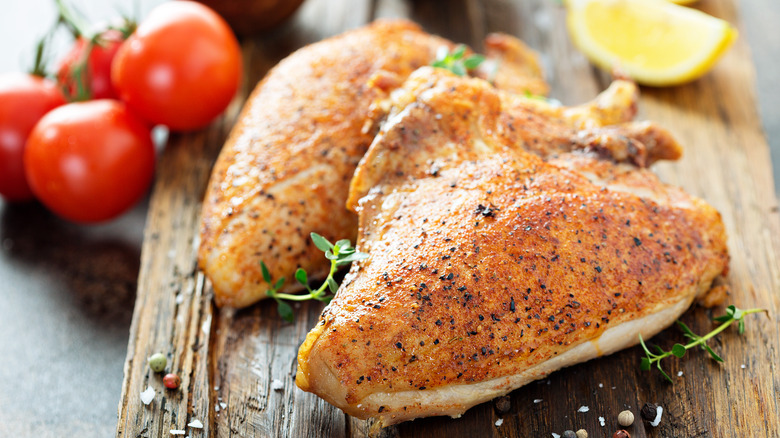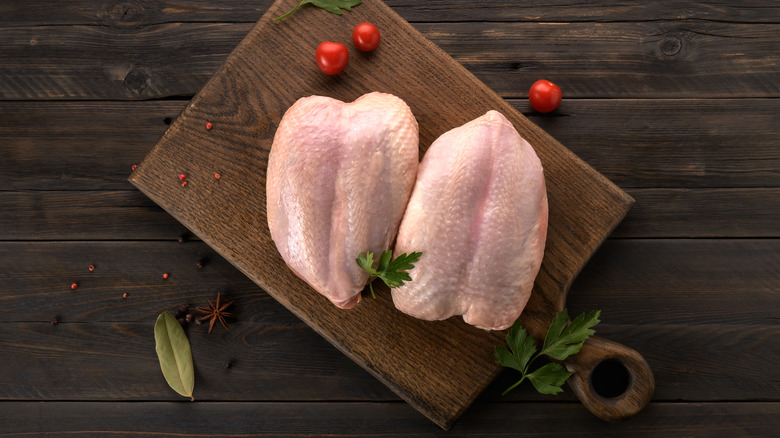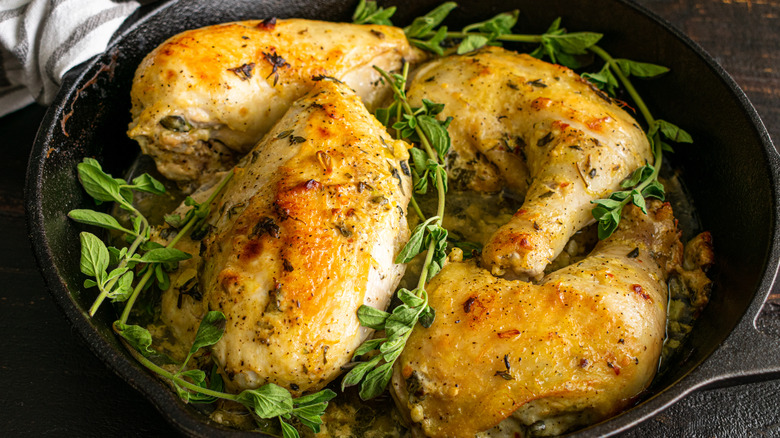Never Overcook Chicken Breasts Again With One Simple Swap
If you're a chicken aficionado, you know that the breast gets a bad rap as one of the worst cuts of meat. It dries quickly, it doesn't retain much flavor or juices, and is, frankly, boring. But what if we told you there is an excellent way to zhuzh it up and pack a ton of flavor in this cut?
For starters: Skinless, boneless chicken breast is bland-central. The more "less" on the label, the less flavor you will end up with. Buying chicken breast bone-in and skin-on will provide more insulation to lock in moisture. Better yet, the cut is generally cheaper than boneless, skinless chicken breast. This is because manufacturers don't have to debone and skin the meat, so the cost of production stays lower. And there's more yum for us! Here's why swapping your boneless chicken breast for bone-in chicken breast will make a world of difference and prevent your protein from drying out.
Bone-in, skin-on
Bone-in, skin-on chicken breast tends to retain more moisture during cooking compared to boneless, skinless cuts. The bone acts as an insulator, helping to prevent the meat from drying out. It also helps to slow down the cooking process, allowing the meat to cook more evenly and stay juicy. Think of the bone as a little baking rod inside the meat.
The skin provides extra protection and flavor, so the meat doesn't overcook. Plus, who doesn't love crispy skin? If you're making grilled chicken with the skin on, it becomes crispy, adding texture and a savory umami component to the dish. It's also a lovely contrast to the tender meat.
As a good rule of thumb, check the temperature of the meat with a meat thermometer to make sure it's done and not overcooked. When checking the temperature of the chicken breast, which should be 165 degrees Fahrenheit, make sure your thermometer does not hit the bone. The bone will have a different temperature than the meat. Allow the cooked chicken breast to rest for a few minutes before slicing. This will help the juices to redistribute, keeping the chicken breast moist.
Keep it moist
The bone and skin certainly help retain moisture. But there are other ways that you can help pack the maximum amount of juiciness in the cooking process. Brining chicken breast is so important, and putting it in a saltwater solution before cooking can help retain moisture. This is especially useful for preventing dryness during baking, grilling, or barbecuing. Flavorful wet marinades with an acidic component are also helpful. A tahini-marinated grilled chicken recipe, for example, uses plenty of lemon juice. The acidity tenderizes the meat and maintains its juiciness. Pan-searing chicken breast in a hot pan with some oil creates a flavorful crust and helps lock in moisture.
Bone-in, skin-on chicken breast is, of course, ideal for recipes that need the full cut of meat intact. For recipes like chicken curries and stews — where cut pieces of chicken are simmered in a sauce or broth — a boneless, skinless chicken thigh or breast cut is easier to handle. But trust us when we say that the bone and skin will help you make the most delicious, juicy chicken breast the next time you're rushing to get dinner on the table.


